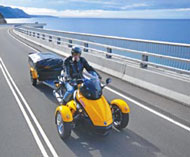
Rocky Road no more
This concrete fantasy didn’t just happen, you know
Bill Bryson, in his far too kind book about how to get a killer hangover called Down Under, at one point has a look at some more or less poisonous spiders in the Natural History Museum in Sydney. Then, to calm down, he goes “off to look at minerals, which aren’t so exciting but do have the compensating virtue that almost never will they attack you”.
Not true, of course, Mr Bryson. Not in Australia!
Those roadside signs that advise you of the fact that “Falling Rocks Don’t Stop” are not only, as popular prejudice would have it, an oxymoronic statement of the first order. They also warn of the habit that the minerals in that general area have of dropping onto the roadway; along the way, potentially at least, striking your head or other parts of yourself or your motorcycle.
An entire “bridge”, the truly striking (pun intended) Sea Cliff Bridge on the way along the coast from Sydney to Wollongong, was built to preclude the effects of this aggressive mineral habit.
The Sea Cliff Bridge forms part of the rather grandly-named Grand Pacific Drive and is 60 kilometres south of central Sydney. It was built at a total cost of $52 million and opened on December 11, 2005. Its purpose was as a defence against precisely the minerals Mr Bryson dismisses so cursorily. It is not really a bridge in the accepted sense that it traverses something like a river, railway line or other road. It’s more a way of sticking the road out into space instead of running it along under the cliff – and therein lies its reason for being.
As well as connecting a string of small townships with Sydney, the Grand Pacific Drive is quite a scenic road. It had long, however, been notorious for rock falls, embankment slips, mud and rock slides due to high rainfall, marine erosion, weak rock and the weathering of rock features. The rock falls caused many road closures throughout the road’s history.
Previously called Lawrence Hargrave Drive after Australia’s pioneer of aviation, the road was built in the 1860s. The problem is that the lower part of the cliff it hugs is a section of the Illawarra coal measures. These measures are made up of layers of coal, clay and stone and when exposed to the weather and the ocean, erode very rapidly. Then you get unstable overhangs that predictably enough fall occasionally.
This is nothing new. You may recall Peter Cook and Dudley Moore discussing the formation of the coal measures, which were made possible by the collapse of prehistoric forests.
“Oh dear, trees falling on us,” Cook quotes the then-locals as saying. “That’s the last thing we want.”
“And of course in many cases that was exactly what they got,” Moore replies.
Where was I? Rocks falling on us.
In August 2003, a large embankment slip led to a complete road closure. The locals, who lost most of their drive-by business and had to go all the way back to Bulli Pass if they wanted to drive to Sydney themselves, jacked up.
“The indefinite closure of Lawrence Hargrave Drive is inflicting needless suffering on (Wollongong’s) northern suburbs residents and business owners and it has to stop. It was bad enough when the road was closed every time 35mm of rain fell but this latest move is crippling the northern suburbs,” local MP Michael Organ said.
The road was closed for 2½ years but now it has a spectacular tourist attraction and real estate values along it have boomed. Rocks, meanwhile, fall safely into the sea. A good result all round, really.
It’s fun to ride over it and there’s a great view of the Sea Cliff Bridge from Lawrence Hargrave Lookout at Stanwell Tops.
